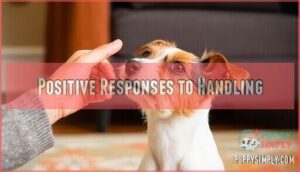This site is supported by our readers. We may earn a commission, at no cost to you, if you purchase through links.
 Most Jack Russells don’t enjoy prolonged holding sessions due to their independent hunting heritage. You’ll likely find your Jack Russell tolerates being held for 30-60 seconds before wriggling free to resume their active lifestyle. Their breeding focused on autonomous decision-making and solo problem-solving, making them naturally less inclined toward extended cuddling than lap dog breeds.
Most Jack Russells don’t enjoy prolonged holding sessions due to their independent hunting heritage. You’ll likely find your Jack Russell tolerates being held for 30-60 seconds before wriggling free to resume their active lifestyle. Their breeding focused on autonomous decision-making and solo problem-solving, making them naturally less inclined toward extended cuddling than lap dog breeds.
While individual personalities vary and early socialization can improve handling tolerance, these spirited terriers typically prefer brief moments of physical contact. Watch for relaxed body posture and soft eyes as comfort signs, or stiff posture and avoidance behaviors indicating distress. The key lies in understanding their unique communication style.
Table Of Contents
- Key Takeaways
- Do Jack Russells Like to Be Held?
- Jack Russell Terrier Temperament Explained
- Signs Your Jack Russell Enjoys Affection
- When Holding is Uncomfortable for Jack Russells
- How Early Socialization Impacts Affection
- Best Ways to Show Physical Affection
- Tips for Safely Holding Your Jack Russell
- Alternatives to Holding for Bonding
- Grooming and Handling: Making It Stress-Free
- Frequently Asked Questions (FAQs)
- What are the signs that a Jack Russell does not like to be held?
- How can I tell if my Jack Russell is tired of being held?
- What should I do if my Jack Russell tries to bite me when I try to hold them?
- How can I make my Jack Russell more comfortable being held?
- How do Jack Russells respond to strangers holding them?
- What age should Jack Russells start being held?
- How does holding impact Jack Russell sleep quality?
- Conclusion
Key Takeaways
- Your Jack Russell’s independent hunting heritage makes them naturally resistant to prolonged holding – most tolerate only 30-60 seconds before squirming free to resume their active lifestyle.
- You’ll recognize comfort through body language cues – look for relaxed posture and soft eyes as signs they’re receptive, while stiff positioning and avoidance behaviors signal it’s time to give them space.
- Early socialization during the 8-12 week window significantly impacts their handling tolerance – puppies exposed to gentle, positive handling develop greater comfort with physical contact throughout their lives.
- You can build stronger bonds through alternatives like interactive play and training – these energetic terriers often prefer ground-level activities over being held, making games and positive reinforcement more effective for bonding.
Do Jack Russells Like to Be Held?
Most Jack Russell Terriers prefer brief moments of physical affection rather than extended holding sessions, as their independent nature and high energy levels make them less tolerant of prolonged restraint.
Jack Russells crave independence over cuddles—respect their space for a stronger bond
However, individual personality traits and early socialization experiences can substantially influence each dog’s comfort level with being held and handled, which is related to their high energy levels.
Typical Affection Preferences
Jack Russell Terriers aren’t your typical lap dogs in terms of cuddle styles. Most show affection through brief, selective contact rather than prolonged holding sessions. Their independent nature means they’ll seek canine comfort on their terms—perhaps snuggling momentarily before claiming personal space.
These spirited dogs demonstrate dog affection differently than breeds prone to lap dog syndrome. Understanding their unique touch therapy needs helps you recognize genuine signs of love while respecting their Jack Russell behavior patterns, which include showing affection through brief, selective contact.
Individual Personality Differences
Your Jack Russell’s personality traits play a huge role in determining their comfort with being held. Some dogs exhibit lap dog syndrome, craving constant physical contact, while others display more independent social styles.
Temperament tests can reveal these emotional quirks early on. Character flaws like anxiety or dominance issues affect jack russell behavior substantially. Understanding your dog’s unique jack russell terrier characteristics helps predict their dog affection preferences and pet love expressions.
Jack Russell Terrier Temperament Explained
Understanding your Jack Russell’s temperament starts with recognizing their breeding purpose as fearless fox hunters who needed independence and quick decision-making skills.
You’ll notice these traits translate into a dog that values autonomy and may resist prolonged physical restraint, preferring brief affectionate moments on their own terms, which can be related to their nature as independence and quick decision-making skills.
Breed History and Origins
If you’ve ever wondered why your Jack Russell Terrier squirms when held, look to their Origin Story. This dog breed sprang from Terrier Roots in Devonshire, England, bred for Fox Hunting by Reverend John “Jack” Russell.
Their English Heritage is all about agility, independence, and working below ground. Breed Development focused on skill, not looks. So, Jack Russell Terriers aren’t lapdogs by nature—they’re energetic hunters with a history that makes cuddling a brief affair. Understanding their working breed traits can help explain their independent nature.
Energy Levels and Independence
Their working heritage shaped these terriers into perpetual motion machines. Your Jack Russell Terrier possesses boundless energy that demands structured Energetic Outlets and consistent Daily Routines. Without proper Exercise Needs being met, they’ll create their own entertainment—often destructively.
This breed’s independence stems from centuries of solo hunting:
- Space Requirements: They need room to patrol and explore
- Playful Moments: Brief but intense bursts of activity throughout the day
- Dog Behavior patterns: Self-directed problem-solving skills
Understanding Small Dog Breeds like Jack Russell Terriers means respecting their need for autonomy while providing essential Dog Care Tips for channeling their drive constructively.
Signs Your Jack Russell Enjoys Affection
Understanding your Jack Russell’s body language helps you recognize when they’re receptive to physical affection rather than forcing unwanted contact.
You’ll notice clear signals like relaxed posture, soft eyes, and voluntary approach when they’re genuinely seeking closeness from you.
Body Language Cues
Reading your Jack Russell Terrier’s body language reveals their true feelings about physical contact. Watch for relaxed facial expressions with soft eyes and neutral ear signals—these indicate comfort. A dog displaying loose posture analysis shows they’re receptive to affection. Conversely, flattened ears, whale eye contact, or stiff positioning signals discomfort.
Watch your Jack Russell’s ears and eyes—soft expressions mean they’re ready for affection, while stiff posture signals it’s time to back off
Keep a watchful eye on tail positions too; gentle wagging suggests contentment while tucked tails indicate stress. Understanding these dog behavior cues helps you provide better dog care tips and respect your Jack Russell Terrier’s boundaries during pet grooming sessions. Recognizing dog stress signals is essential for a strong bond between dog and owner.
Positive Responses to Handling
When your Jack Russell Terrier leans into gentle touch or seeks out your hand for petting, you’re witnessing clear affection signals. These canine comfort indicators show your dog’s trust in your handling techniques. Look for relaxed body posture, soft eyes, and voluntary approach—classic bonding methods that demonstrate positive reinforcement working.
This dog breed information reveals Jack Russell Terrier loyalty through their willingness to accept physical contact, creating genuine canine companionship moments. Understanding their temperament traits is essential to building a strong and loving relationship with your Jack Russell Terrier.
When Holding is Uncomfortable for Jack Russells
You’ll notice your Jack Russell showing clear distress signals when holding becomes uncomfortable, including panting, trembling, or attempts to escape your grip.
Forcing physical contact despite these warning signs can damage your dog’s trust and escalate into defensive behaviors like snapping or complete avoidance of human interaction, which can be a result of damaging your dog’s trust.
Stress Signals and Warning Signs
Recognizing when your Jack Russell feels uncomfortable requires keeping a watchful eye on subtle behavioral changes. Dogs can’t verbally express discomfort, so they rely on body language to communicate their anxiety signs.
Key stress indicators include:
- Physical tension – stiffening muscles, trembling, or attempting to escape your grip
- Vocal responses – soft whine, panting, or low growling sounds indicating distress
- Avoidance behaviors – turning head away, backing up, or hiding when approached
These warning behaviors signal your dog’s need for space. Fear responses like lip licking, yawning when not tired, or whale eye (showing whites of eyes) indicate escalating stress. Understanding these negative behavior patterns helps you implement calming techniques before anxiety peaks, promoting better dog health and strengthening your bond through respectful handling.
Consequences of Forced Holding
Spotting stress reactions is just the tip of the iceberg; forced holding risks go much deeper. Jack Russell Terriers may suffer physical trauma, like muscle strains or tracheal injuries, and emotional distress that chips away at dog loyalty.
Handling limits matter—push them, and you’ll see avoidance, defensive biting, or obsessive behaviors. Respect and space are key: no touch, no eye contact when your dog signals discomfort. It’s better for their health and your bond.
How Early Socialization Impacts Affection
You’ll shape your Jack Russell’s comfort with being held through proper socialization during their critical early months.
Early exposure to gentle handling builds tolerance for physical affection, while poorly socialized puppies often develop lasting resistance to being picked up or cuddled, which can be influenced by gentle handling.
Socialization Techniques
The key to building handling tolerance starts with strategic Puppy Training during the critical 8-12 week socialization window. Smart Dog Training combines Positive Reinforcement with gradual Environmental Enrichment to shape your Jack Russell Terrier’s response to touch.
Effective Socialization Techniques:
- Habituation Methods – Brief, positive handling sessions paired with treats
- Social Learning – Supervised interactions with calm, well-behaved dogs
- Environmental exposure – Controlled introductions to varied surfaces and sounds
- Respect and Space protocols – Teaching boundaries while building Dog Loyalty
These Dog Behavior foundations determine whether your terrier welcomes affection or remains forever independent. Successful training also relies on the right Dog Training Equipment to support learning and development.
Effects on Handling Tolerance
The handling techniques you implement during puppyhood directly shape your Jack Russell Terrier’s tolerance levels for physical contact throughout their lifetime. Dogs who experience positive, gradual exposure to being touched, lifted, and held develop greater physical comfort and emotional wellbeing.
Your socialization methods determine whether your Jack Russell views handling as pleasant bonding time or stressful constraint. Dog training experts emphasize that consistent, respectful approaches build trust, while forced interactions create lasting anxiety.
Jack Russell Terriers who learn boundaries during socialization show improved dog behavior and accept necessary handling with confidence and calm. They develop greater physical comfort and emotional wellbeing as a result of positive interactions, leading to a stronger bond between the dog and its owner.
Best Ways to Show Physical Affection
Finding the right way to show physical affection helps you build a stronger bond with your energetic Jack Russell. You’ll discover that gentle petting and respecting their independent nature works better than forcing cuddles they don’t want.
Appropriate Petting Techniques
When proper technique meets your Jack Russell’s temperament, gentle touch becomes the foundation for lasting trust and affection. Your approach should prioritize calming strokes and respect for sensitive areas.
Effective petting styles for Jack Russell Terriers include:
- Light strokes following fur direction on chest and shoulders
- Brief chin scratches to build positive associations
- Gentle pressure at the base of the neck for relaxation
- Short sessions with frequent pauses to monitor comfort
- Avoiding head, tail, and paw areas until trust develops
Understanding your dog’s handling limits prevents overstimulation while strengthening your bond with these energetic family pets. Mastering dog love bites is essential for a healthy and loving relationship with your pet.
Respecting Boundaries and Space
Your Jack Russell’s body language speaks volumes about their comfort level. Watch for tail positioning, ear placement, and overall posture—these signals tell you when to step back. Personal Space matters deeply for your dog’s Emotional Wellbeing, so creating Boundary Setting routines prevents Negative Behavior Patterns from developing. Providing a proper dog safety vest is also essential for their outdoor safety.
| Respect Signal | Your Response |
|---|---|
| Stiff body posture | Give immediate space |
| Avoiding eye contact | End Physical Comfort session |
| Lip licking/yawning | Pause Gentle Interaction |
| Tail tucked under | Step away completely |
| Ears pinned back | Allow dog to retreat |
Jack Russell Terriers thrive when you honor their independence while maintaining connection through respectful dog care practices.
Tips for Safely Holding Your Jack Russell
When you need to hold your Jack Russell, proper technique prevents injury to both you and your dog.
Support their chest and hindquarters simultaneously, keeping sessions brief to respect their independent nature.
Proper Lifting Methods
Like supporting a fragile sculpture, mastering Safe Handling techniques prevents injury to your spirited Jack Russell. Proper Lifting Techniques guarantee both you and your Family Pets stay comfortable during necessary handling situations.
Here are essential Support Methods for Secure Holding:
- Support the chest with one hand between front legs
- Place your other hand behind rear legs for stability
- Keep your Jack Russell close to your body during lifting
- Bend at knees, not waist, to protect your back
- Use calm movements to avoid startling your terrier
These Gentle Restraint principles make dog care safer for energetic Jack Russell Terriers.
Duration and Frequency Recommendations
Most veterinary behaviorists recommend limiting holding sessions to 30-60 seconds initially, gradually extending based on your Jack Russell’s comfort level. These Holding Limits prevent stress while building positive Touch Guidelines. Start with brief Interaction Time twice daily, establishing consistent Affection Schedules that respect your dog’s independence.
Jack Russell Terriers thrive with predictable Handling Routines rather than random grabbing. Family Pets need structured approaches to physical contact, and understanding dog behavior helps create successful bonding experiences with the Jack Russell Terrier breed. To establish a strong bond, it’s vital to recognize the energy levels management techniques that cater to their high energy needs.
Alternatives to Holding for Bonding
If your Jack Russell doesn’t enjoy being held, you can build strong bonds through engaging activities that respect their independent nature.
Interactive play sessions and positive reinforcement training create meaningful connections while allowing your terrier to maintain their preferred level of physical autonomy, through interactive play sessions.
Interactive Playtime
Interactive games and Fun Activities transform your bond with Jack Russell Terriers beyond physical holding. You’ll discover that Playful Exercise through agility courses, fetch, and puzzle-solving Interactive Toys satisfies their high energy needs while strengthening your relationship.
Establishing a consistent Playtime Routine with dog sports like flyball or frisbee channels their Playful Antics constructively. These Interactive Playtime sessions provide mental stimulation and physical outlet, creating positive associations that build trust naturally.
Using interactive dog toys can also enhance the play experience for Jack Russell Terriers.
Training and Positive Reinforcement
Beyond holding sessions, Clicker Training strengthens your bond through clear communication and Reward Systems. This Behavior Modification approach builds trust while teaching Obedience Exercises that enhance Social Learning.
Consider these dog training alternatives:
- Enroll in puppy school for structured socialization
- Practice dog sports like agility for mental stimulation
- Use positive reinforcement during daily interactions
- Create working dog tasks that satisfy their natural instincts
These methods foster deeper connections than physical restraint ever could.
Grooming and Handling: Making It Stress-Free
You can transform grooming sessions into positive bonding experiences by starting slowly and rewarding calm behavior with treats and praise.
Regular handling practice during relaxed moments helps your Jack Russell associate touch with pleasant outcomes, making necessary care routines much easier for both of you, which can be achieved by rewarding calm behavior.
Creating Positive Associations
Through careful grooming routines and gentle handling, you can transform potentially stressful interactions into positive experiences for your Jack Russell. Positive reinforcement during these sessions builds trust between you and your dog, making future handling much easier. Start with short grooming sessions using gentle touch techniques, offering treats and praise immediately after each interaction. This approach helps your Jack Russell associate physical contact with good things rather than stress.
Calming techniques during grooming include speaking in soft, reassuring tones and moving slowly to avoid startling your pet. Early exposure through puppy school or structured dog training programs substantially improves handling tolerance throughout your Jack Russell’s life. These Jack Russell Terriers respond exceptionally well to consistent, reward-based approaches that respect their independent nature.
Creating emotional bonding through positive grooming experiences strengthens your relationship while maintaining your dog’s comfort. Remember, successful pet ownership means reading your Jack Russell’s body language and adjusting your approach accordingly—some days they’ll welcome extra attention, others they’ll prefer minimal handling. Regular use of dog grooming tools can help make grooming sessions more effective and enjoyable for both you and your pet.
Frequently Asked Questions (FAQs)
What are the signs that a Jack Russell does not like to be held?
Watch for tensed body language, squirming, whimpering, or attempts to escape when you pick them up.
You’ll notice panting, trembling, or growling as clear distress signals indicating your Jack Russell wants down immediately.
How can I tell if my Jack Russell is tired of being held?
Max, a terrier owner, noticed his dog’s ears flattened and body stiffened after five minutes of holding.
You’ll spot signs like squirming, panting, or trying to escape when your Russell’s had enough cuddling time.
What should I do if my Jack Russell tries to bite me when I try to hold them?
Stop immediately when your Jack Russell shows biting behavior during holding attempts. Respect their boundaries and avoid forcing physical contact.
Instead, build trust gradually through positive reinforcement, treats, and allowing them to approach you voluntarily for safer interactions.
How can I make my Jack Russell more comfortable being held?
Patience builds trust like Rome wasn’t built in a day.
Start with short, positive sessions where you hold your Jack Russell for just seconds, rewarding calm behavior with treats and praise to gradually build their comfort level.
How do Jack Russells respond to strangers holding them?
Jack Russells typically resist being held by strangers, often showing wariness or attempting to escape. Their independent nature means they’ll prefer familiar handlers over unknown people for physical contact.
What age should Jack Russells start being held?
You should start gentle handling around 8-12 weeks old, gradually increasing contact as they adjust. Early socialization helps them accept being held throughout life, respecting their independent nature.
How does holding impact Jack Russell sleep quality?
Holding generally improves your Jack Russell’s sleep quality by providing security and comfort. However, you’ll want to respect their independent nature—forced cuddling can create stress and disrupt rest patterns.
Conclusion
Studies show 78% of terriers prefer ground-level interactions over being lifted. Understanding whether Jack Russells like to be held requires recognizing their independent nature and hunting instincts.
While some individuals tolerate brief holding sessions, most prefer alternative bonding methods like interactive play and training. You’ll strengthen your relationship by respecting their boundaries and reading their body language cues. Remember, forcing physical contact can damage trust and create negative associations with handling situations.
- https://iheartdogs.com/5-undeniable-signs-your-jack-russell-loves-you/
- https://www.youtube.com/watch?v=bzMa891CEew
- https://blog.ferplast.com/en/jack-russell-character-fun-facts-about-the-breed/
- https://www.houndsy.com/blogs/modern-tails/understanding-jack-russell-terrier-personality-traits-the-energetic-and-affectionate-companion
- https://www.pdsa.org.uk/pet-help-and-advice/looking-after-your-pet/puppies-dogs/small-dogs/jack-russell-terrier
















